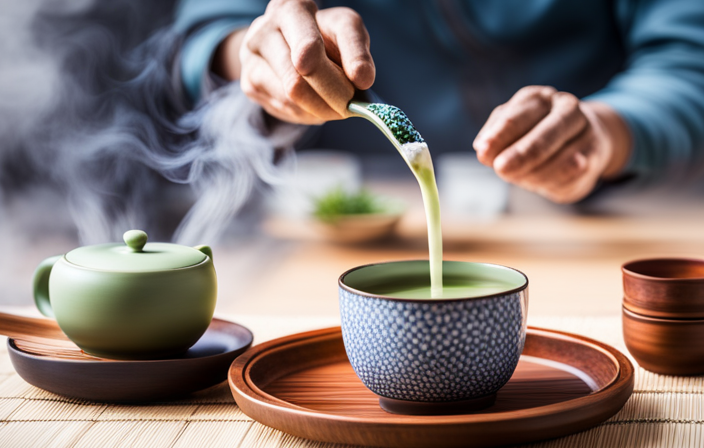Turmeric Tea
How To Make Curcumic Turmeric Tea
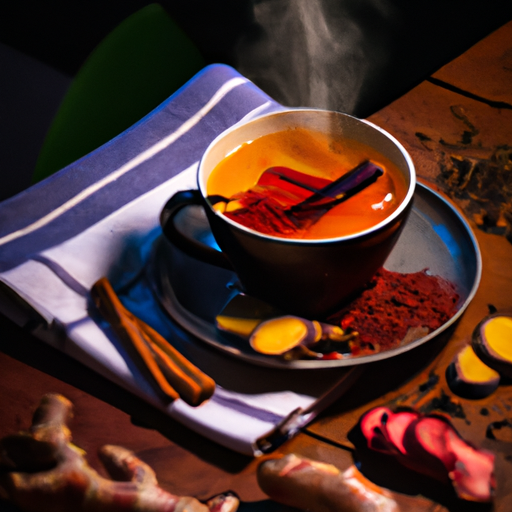
I really enjoy beginning my day with a cozy mug of curcumin turmeric tea. It’s not only tasty and soothing, but it also offers many health benefits that give me a boost of energy and prepare me for the day ahead.
Curcumin, the active ingredient in turmeric, has been shown to have anti-inflammatory properties and may help reduce the risk of chronic diseases such as heart disease, cancer, and Alzheimer’s.
Plus, adding ginger to your tea can aid in digestion and boost immunity.
With all these benefits in mind, let me show you how easy it is to make this tasty and nutritious beverage at home!
Key Takeaways
- Turmeric tea has anti-inflammatory properties and can boost immunity.
- To make turmeric tea, you will need fresh turmeric root or powder, ginger, honey, lemon, and water.
- Ginger aids digestion and honey is a natural sweetener with antibacterial properties, while lemon enhances absorption of curcumin.
- Variations include enjoying the tea hot or cold, using alternative sweeteners, and adding black pepper, cinnamon, cardamom, or coconut or almond milk for different flavors.
Benefits of Curcumin Turmeric Tea
If you want to experience the amazing benefits of curcumin turmeric tea, you’ve gotta try brewing a cup for yourself! One of the most well-known benefits of this tea is its anti-inflammatory properties. Curcumin, the active ingredient in turmeric, has been shown to reduce inflammation in the body and may even be as effective as some anti-inflammatory drugs. This makes it a great choice for those with inflammatory conditions such as arthritis.
In addition to its anti-inflammatory properties, curcumin turmeric tea also provides support for the immune system. Research has shown that curcumin can help boost immunity by increasing the activity of certain immune cells. This means that drinking this tea regularly could help protect against infections and illnesses.
So, now that you know about these incredible benefits, it’s time to gather your ingredients and start brewing!
Gather Ingredients
So, to make a delicious and healthy cup of turmeric tea, the first step is to gather all the necessary ingredients. I usually go for fresh turmeric root or powder, ginger, honey, lemon, and water.
These are the key players that make this tea so nutritious and flavorful. By combining these ingredients in just the right way, you can create a drink that not only tastes great but also has remarkable health benefits.
Turmeric Root or Powder
Turmeric adds a warm and earthy flavor to your tea, whether you use fresh turmeric root or ground powder. It’s a commonly used spice in many cultures, especially in Indian and Southeast Asian cuisine. Turmeric has also gained popularity for its health benefits, such as reducing inflammation and improving brain function. Adding turmeric to your tea not only enhances the taste but also provides potential health benefits.
There are various turmeric recipes that you can try when making tea. You can use fresh turmeric root by grating it or slicing it thinly and boiling it with water for at least 10 minutes. Alternatively, you can use ground turmeric powder by adding half a teaspoon of it into hot water or milk and stirring well. Whichever method you choose, make sure to strain the liquid before serving to remove any solid particles.
Now let’s move on to the next step – ginger!
Ginger
Now, you’re probably wondering how to add a bit of zing to your brew. Let’s talk about ginger! This root has been used for centuries in traditional medicine and cooking. Adding ginger to turmeric tea not only adds flavor but also provides numerous health benefits.
Firstly, ginger is known for its anti-inflammatory properties. It can help reduce pain and swelling in the body. Secondly, it aids digestion by promoting the production of digestive enzymes and reducing nausea. Lastly, ginger has been shown to boost the immune system and fight off infections.
So, next time you make your turmeric tea, don’t forget to add a slice or two of fresh ginger!
Speaking of flavor enhancers, let’s move onto honey which not only sweetens the tea but also has its own set of health benefits.
Honey
Honey, a natural sweetener with antibacterial properties, is a delicious addition to turmeric tea that can also provide numerous health benefits. When combined with turmeric’s anti-inflammatory and antioxidant properties, honey can help combat infections and boost the immune system.
It’s important to note that not all honey is created equal, as some store-bought varieties may contain added sugars or preservatives. To reap the full benefits of honey in your turmeric tea, opt for raw, unprocessed honey from a trusted source.
Using honey in other turmeric recipes is also a great way to incorporate this natural sweetener into your diet. For example, you can add honey to homemade golden milk or use it as a glaze for roasted vegetables seasoned with turmeric.
Additionally, drinking honey-sweetened turmeric tea before bed has been shown to improve sleep quality and reduce stress levels. So next time you brew up a pot of curcumin-rich tea, don’t forget the honey!
Transitioning into the next section about ‘lemon,’ adding lemon juice to your turmeric tea not only adds a refreshing zing but also enhances the absorption of curcumin by up to 2000%.
Lemon
Adding a splash of lemon juice to your turmeric beverage can pack a punch and help you absorb the benefits of this powerful spice like never before. Lemon is known for its high vitamin C content, which acts as an antioxidant and helps in the absorption of curcumin – the active compound found in turmeric. Not only that, but lemon also adds a refreshing flavor to your drink, making it even more enjoyable.
Here are some ways you can incorporate lemon into your turmeric tea:
- Squeeze fresh lemon juice into your tea after brewing.
- Add thin slices of lemon to your tea while it’s steeping.
- Create a zesty twist by adding grated lemon zest to your turmeric tea.
- Mix in a teaspoon of honey with freshly squeezed lemon juice for added sweetness.
Aside from enhancing the flavor profile and boosting nutrient absorption, drinking lemon tea has many health benefits on its own. It’s known for its ability to aid digestion, boost immunity, and improve skin health.
In fact, there are many simple recipes available online that show how easy it is to make delicious and healthy cups of hot or cold lemon tea at home.
As we move forward in our quest for perfecting our turmeric beverage recipe, let’s not forget about another essential ingredient – water.
Water
To fully reap the health benefits of your curcumin turmeric tea, it is important to use clean and filtered water. Water plays a crucial role in hydrating our bodies and aiding in the absorption of nutrients. When making turmeric tea, water also helps to extract the beneficial compounds from the turmeric root or powder.
It is recommended to drink at least 8 glasses of water per day for optimal hydration. This is especially important when consuming beverages with diuretic properties, such as caffeine or alcohol, which can increase fluid loss. By choosing clean and filtered water when making your turmeric tea, you can ensure that you are not adding any harmful contaminants or impurities into your body. In the table below, we explore some additional benefits of staying hydrated with clean and filtered water:
| Hydration Benefits | Effects on Body |
|---|---|
| Improves digestion | Helps flush out toxins |
| Increases energy levels | Aids in weight loss |
| Promotes healthy skin | Reduces headaches |
Now that we understand the importance of using clean and filtered water when making curcumin turmeric tea, let’s move on to preparing either fresh turmeric root or powder for our beverage.
Prepare Turmeric Root or Powder
First, you’ll need to peel and grate fresh turmeric root or measure out the desired amount of turmeric powder.
Turmeric has been used for centuries in Ayurvedic medicine and has many health benefits such as reducing inflammation, boosting immunity, and aiding digestion.
Adding it to tea is a great way to incorporate it into your daily routine.
To use fresh turmeric root, simply peel the skin off with a vegetable peeler or spoon and grate it finely using a grater or food processor.
For dried turmeric powder, measure out 1-2 teaspoons per cup of water depending on how strong you like your tea.
Once you have your desired amount ready, move on to boiling water to make your delicious cup of turmeric tea.
Boil Water
As you wait for the water to boil, it’s worth taking a moment to appreciate the benefits of drinking boiled water. Boiling water kills any harmful pathogens that may be present, making it a great way to ensure that your tea is safe and healthy to drink. Additionally, boiling water is an essential step in many different types of tea-making processes, from traditional teas like black tea and green tea to herbal blends.
Once the water comes to a rolling boil, you’re ready to add your turmeric and ginger root or powder. But before we move on to that step, let’s talk about some of the different types of tea made with boiling water.
Whether you prefer classic black tea or are looking for something more adventurous like matcha or chai, there are countless varieties of tea that can be brewed using this simple technique. With so many options available, it’s easy to find a blend that suits your taste preferences and provides health benefits as well.
Add Turmeric and Ginger
Now that we’ve boiled the water, it’s time to add the key ingredients for our turmeric tea. First, I like to add a teaspoon of ground turmeric and half a teaspoon of freshly grated ginger root.
Turmeric contains an active compound called curcumin, which has powerful anti-inflammatory properties. It can help reduce pain and swelling in the body while also providing antioxidant benefits. Ginger is also known for its anti-inflammatory effects and can help with digestion and nausea.
Combining these two ingredients creates a potent combination that not only tastes delicious but also provides numerous health benefits. The turmeric tea benefits are enhanced when paired with ginger due to their synergistic effects on inflammation and digestion.
Once you’ve added both ingredients, stir well to ensure they are evenly distributed throughout the water. Now, we move on to simmering our mixture for 10-15 minutes to allow all the flavors to meld together perfectly.
Simmer for 10-15 Minutes
To fully infuse the flavors of the ginger and turmeric into the water, let it simmer for 10-15 minutes while occasionally stirring to create a warm and comforting drink that will nourish your body from the inside out. Simmering allows all of the ingredients to blend together, releasing their essential oils, antioxidants, and anti-inflammatory properties into this delicious tea.
Simmering also brings out different variations in flavor depending on how long you let it sit. If you want a milder taste, keep it at 10 minutes. But if you’re looking for something stronger and more potent, let it simmer for up to 15 minutes. Regardless of how long you choose to simmer your tea, one thing is certain – this simple step is essential in unlocking all of its health benefits. Now that your tea has finished simmering, we’re ready to move onto the next step: straining!
Strain the Tea
You’ll want to strain the ginger and turmeric tea before enjoying it. Straining the tea will remove any bits of ginger or turmeric that may have made their way into your cup.
There are a few different types of tea strainers you can use for this task, such as mesh strainers, cloth filters, or even disposable paper filters. If using a mesh strainer, simply place it over your mug or teapot and pour the tea through it. For a cloth filter, place it inside a funnel and pour the tea through it slowly. If using a paper filter, place it in a small wire basket and set it over your mug before pouring the tea through.
Whichever method you choose, be sure to press down on any remaining bits of ginger or turmeric to extract all of the flavorful liquid.
Now that you’ve strained your ginger and turmeric tea, it’s time to add some honey and lemon for extra flavor and health benefits. Simply squeeze half a lemon into your cup along with one tablespoon of honey (adjusting to taste). Stir well until everything is combined, then sit back and enjoy!
Add Honey and Lemon
Now it’s time to sweeten up our freshly strained turmeric tea! I like to add a spoonful of honey for a natural sweetener that also has some health benefits. Honey is packed with antioxidants and has been shown to have antibacterial properties. Plus, it gives the tea a lovely flavor that complements the earthy taste of turmeric.
And don’t forget to add a splash of fresh lemon juice – not only does it enhance the flavor, but it also adds some extra vitamin C to your cup!
Sweeten with Honey
Hey, if you’ve got a sweet tooth, why not add a dollop of honey to your turmeric tea? Not only will it make your tea taste better, but honey also comes with numerous health benefits.
Honey has been used for centuries as a natural remedy to treat coughs and sore throats. It’s also rich in antioxidants that help protect your body against cell damage caused by free radicals.
If you’re looking for an alternative sweetener for your turmeric tea, honey is definitely worth considering. To sweeten your turmeric tea with honey, simply add one to two teaspoons of honey into the cup before pouring in the hot water. Stir until the honey dissolves completely and enjoy! If you prefer a sweeter taste, feel free to add more honey.
Now that we’ve added some sweetness to our turmeric tea, let’s move on to the next step – adding fresh lemon juice which can enhance both its flavor and nutritional value.
Add Fresh Lemon Juice
Adding fresh lemon juice to your turmeric drink can not only enhance its flavor but also boost its nutritional value. Lemon is a great source of vitamin C, which helps the body absorb curcumin, the active compound in turmeric.
Here are three reasons why adding fresh lemon juice to your turmeric tea is a great idea:
-
Health benefits: Lemon juice contains antioxidants that can help protect the body against damage from free radicals. It’s been shown to have anti-inflammatory properties and may even help reduce the risk of heart disease.
-
Alternative options: If you don’t like the taste of honey or want to avoid added sugars, lemon juice provides a natural sweetness without any extra calories. You can also add other herbs and spices like ginger or cinnamon for additional flavor and health benefits.
-
Nutritional value: Adding lemon juice to your turmeric drink increases its vitamin C content, which supports immune function and skin health. Lemon also contains potassium, which plays an important role in regulating blood pressure.
Now that we’ve added fresh lemon juice to our turmeric tea, it’s time to serve and enjoy!
Serve and Enjoy!
To savor your delicious cup of turmeric tea, simply grab a cozy spot, take a sip, and let the warmth spread throughout your body. You may choose to add some honey or maple syrup for sweetness, or experiment with different tea variations like adding ginger or cinnamon.
For serving suggestions, you can enjoy it hot or cold and even try incorporating it into your daily routine as a healthy alternative to coffee. As you sip on your turmeric tea, take note of its rich color and aroma.
Turmeric has been used for centuries in Ayurvedic medicine due to its numerous health benefits such as reducing inflammation and boosting immunity. So sit back, relax, and indulge in this nourishing beverage.
Next up, I’ll share some additional tips on how to make the most out of your turmeric tea experience.
Additional Tips
Now that you’ve got the hang of brewing this healthy and flavorful concoction, let me give you some insider tips to really make your turmeric tea shine like a diamond in the rough.
First off, there are a variety of alternative sweeteners you can use if honey isn’t your thing. Try maple syrup or agave nectar for a different flavor profile. Stevia’s also a great option for those watching their sugar intake.
Secondly, don’t be afraid to experiment with brewing variations. Some people prefer to add black pepper or ginger for an added kick, while others like to mix in coconut milk or almond milk for a creamier texture. You can even try adding cinnamon or cardamom for an extra boost of flavor.
The possibilities are endless, so don’t be afraid to get creative and find what works best for your taste buds!
Frequently Asked Questions
Can I use ground turmeric instead of fresh turmeric root?
Yes, I prefer using ground turmeric for my turmeric tea recipe. It’s an easy and convenient alternative to fresh turmeric root. Just add 1/2 teaspoon of ground turmeric to hot water with ginger and honey for a delicious and healthy drink.
How much honey and lemon should I add to the tea?
For the perfect honey and lemon ratio in turmeric tea, I recommend adding 1 tablespoon of honey and half a lemon’s worth of juice per cup. Honey not only adds sweetness but also has antibacterial properties that enhance the health benefits of turmeric tea.
Can I make a large batch of the tea and store it in the fridge for later consumption?
Yes, I often make a large batch of curcumin tea and store it in the fridge for later consumption. To prepare curcumin tea in advance, let it cool down, transfer to an airtight container and refrigerate.
Does the tea have any potential side effects or interactions with medications?
When consuming turmeric tea, it’s important to be aware of potential side effects and drug interactions. Precautions include avoiding if pregnant or taking blood thinners. Consult with a healthcare provider before incorporating into your routine.
Can I add other herbs or spices to the tea for additional health benefits?
Adding herbs and spices to your tea can provide additional health benefits. Did you know that over 80% of the world’s population uses plants for medicinal purposes? Incorporating herbs like ginger or cinnamon can boost immunity and reduce inflammation.
Conclusion
Well, folks, that’s how I make my delicious and healthy curcumin turmeric tea! Trust me, this tea is a game-changer when it comes to overall health and wellness.
Not only does it help with inflammation and digestion, but it also boosts the immune system and promotes healthy skin. As the saying goes, ‘an apple a day keeps the doctor away,’ but in this case, a cup of turmeric tea can do wonders for your body.
So why not give it a try? With just a few simple ingredients and steps, you can easily make this tasty beverage at home. Plus, you can customize it to your liking by adding different spices or sweeteners.
So what are you waiting for? Grab some turmeric root or powder today and get brewing!
Turmeric Tea
What Happens To Your Body When You Drink Turmeric
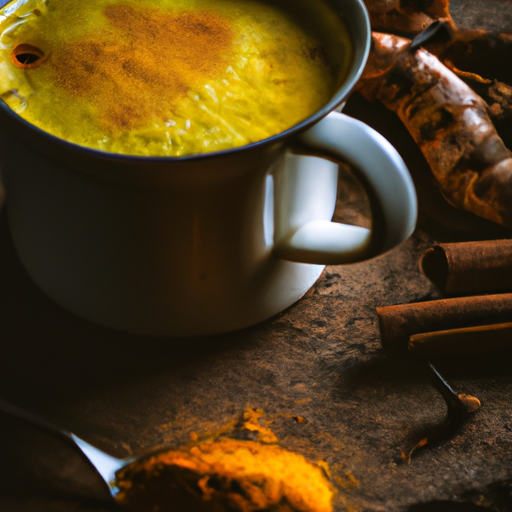
Hello, fellow health enthusiasts! As the saying goes, ‘An apple a day keeps the doctor away.’ But what if I told you there’s another potent remedy that can greatly benefit your body?
Yep, I’m talking about turmeric, that vibrant yellow spice that adds a burst of flavor to your favorite dishes. But did you know that drinking turmeric can actually have some amazing benefits for your overall well-being?
When you take a sip of turmeric goodness, you’re not only tantalizing your taste buds, but you’re also giving your immune system a much-needed boost. This golden spice contains a compound called curcumin, which has been shown to have powerful antioxidant and anti-inflammatory properties. That means it can help reduce inflammation in the body, improve digestion, and even support brain health.
But that’s not all! Turmeric is also a secret weapon for enhancing your skin health, aiding in weight management, and fighting against chronic diseases. So, whether you’re looking to improve your immune system, soothe inflammation, or just give your overall health a little pick-me-up, turmeric might just be the magical elixir you’ve been searching for.
Cheers to good health!
Key Takeaways
- Drinking turmeric boosts the immune system and stimulates immune cell activity.
- Turmeric reduces inflammation in the body and improves digestion.
- Turmeric aids in weight management by promoting fat burning and reducing inflammation.
- Turmeric supports brain health by reducing inflammation, boosting antioxidant activity, and enhancing neuroplasticity.
Boosts Immune System
Drinking turmeric boosts your immune system, helping to create a shield of protection around your body. Turmeric contains a compound called curcumin, which has been shown to enhance immune function. It stimulates the activity of immune cells, such as T cells, B cells, and natural killer cells, which play a crucial role in fighting off infections and diseases. Studies have also found that curcumin increases the production of certain proteins that regulate immune responses.
By incorporating turmeric into your diet, you can strengthen your immune system and improve your body’s ability to defend against harmful pathogens. Furthermore, turmeric is a natural remedy that’s been used for centuries to promote overall health and wellness. It’s a powerful antioxidant and anti-inflammatory agent, which further supports immune function.
With its numerous benefits, turmeric is a valuable addition to any health-conscious individual’s routine. As we transition to the next section about reducing inflammation, it’s important to note that turmeric’s ability to boost the immune system also contributes to its anti-inflammatory properties.
Reduces Inflammation
Experience the amazing benefits of turmeric as it actively works to reduce inflammation within you. Turmeric contains a compound called curcumin, which has powerful anti-inflammatory properties. By reducing inflammation, turmeric can help alleviate joint pain and ease muscle soreness. But how exactly does turmeric achieve this? Let’s take a closer look at the science behind it.
Studies have shown that curcumin can block certain molecules that play a role in inflammation, such as TNF-alpha and NF-kappaB. This can help reduce the production of inflammatory chemicals in the body, leading to a decrease in inflammation and its associated symptoms. Turmeric’s anti-inflammatory effects have been compared to those of non-steroidal anti-inflammatory drugs (NSAIDs), but without the potential side effects.
Reducing inflammation is just one way turmeric can benefit your body. It also improves digestion by stimulating the production of bile, which aids in the breakdown of fats. So not only can turmeric help reduce inflammation, but it also supports a healthy digestive system.
Improves Digestion
Turmeric’s ability to improve digestion can be visualized as it stimulates the production of bile, aiding in the breakdown of fats. This golden spice has been shown to improve gut health by reducing inflammation in the digestive system and promoting the growth of beneficial gut bacteria. It has also been found to relieve bloating and indigestion by increasing the secretion of digestive enzymes.
Furthermore, turmeric’s active compound, curcumin, has been found to have protective effects on the stomach lining, preventing ulcers and reducing the risk of gastrointestinal disorders. These benefits make turmeric a valuable addition to any diet for those looking to improve their digestive health.
Moving forward, let’s explore how turmeric supports brain health and cognitive function.
Supports Brain Health
To truly enhance your cognitive abilities and protect your brain health, it’s crucial to understand how turmeric can play a pivotal role in supporting these important aspects of your overall well-being. Turmeric has been found to have numerous benefits for brain function and cognitive function. Here are three key ways that turmeric supports brain health:
-
Reduces inflammation: Turmeric contains a compound called curcumin, which has powerful anti-inflammatory properties. Inflammation in the brain has been linked to cognitive decline and neurodegenerative diseases like Alzheimer’s. Turmeric can help reduce inflammation and protect brain cells from damage.
-
Boosts antioxidant activity: Oxidative stress can lead to brain aging and cognitive decline. Turmeric acts as a potent antioxidant, neutralizing harmful free radicals and protecting the brain from oxidative damage.
-
Enhances neuroplasticity: Neuroplasticity refers to the brain’s ability to adapt and form new connections. Studies have shown that curcumin in turmeric can enhance neuroplasticity, promoting learning, memory, and overall cognitive function.
Understanding how turmeric supports brain health is just the first step towards improving your overall well-being.
Next, we’ll explore how turmeric enhances skin health.
Enhances Skin Health
Imagine a world where your skin is as smooth and glowing as a radiant sunrise, and turmeric is the magical elixir that unlocks this beauty secret. Turmeric, the golden spice often found in curries, has been used for centuries in traditional medicine for its numerous health benefits. When it comes to skin health, turmeric has emerged as a powerful ingredient.
Its anti-inflammatory properties make it an effective treatment for acne, reducing redness and irritation. Additionally, turmeric’s antioxidant properties help fight off free radicals that contribute to premature aging, making it a natural anti-aging remedy. Incorporating turmeric into your skincare routine can enhance your skin’s health and give you a youthful, radiant glow.
Now, let’s explore how turmeric aids in weight management.
Aids in Weight Management
If you’re looking to shed a few pounds, incorporating turmeric into your diet can be a helpful aid in managing your weight. Turmeric has been found to have weight loss benefits due to its ability to boost metabolism.
Here are three ways turmeric can support your weight management journey:
-
Increased fat burning: Turmeric contains a compound called curcumin, which has been shown to promote the breakdown of fats and prevent the formation of new fat cells in the body.
-
Reduced inflammation: Chronic inflammation in the body can hinder weight loss efforts. Turmeric has potent anti-inflammatory properties that can help reduce inflammation and promote weight loss.
-
Improved digestion: Turmeric stimulates the production of bile, which aids in the digestion of fats. This can improve your body’s ability to break down and absorb nutrients, leading to better weight management.
Incorporating turmeric into your daily routine can have numerous benefits, including aiding in weight management.
Moving on to the next section, turmeric also fights against chronic diseases.
Fights Against Chronic Diseases
You’ll be amazed at how turmeric fights against chronic diseases and improves your overall health. One of the key benefits of turmeric is its ability to reduce pain and inflammation in the body. Curcumin, the active compound in turmeric, has been shown to have powerful anti-inflammatory properties. This can help alleviate symptoms of chronic diseases such as arthritis and osteoarthritis.
Additionally, turmeric has been found to prevent heart disease by reducing the risk factors associated with it. Studies have shown that curcumin can help lower cholesterol levels, reduce blood pressure, and improve blood vessel function. By incorporating turmeric into your daily routine, you can reap these benefits and protect yourself against chronic diseases while improving your overall well-being.
Frequently Asked Questions
Can turmeric help with managing symptoms of autoimmune diseases?
Yes, turmeric can help manage symptoms of autoimmune diseases. It acts as a natural remedy for inflammation, reducing pain and swelling. It also supports the immune system, helping to regulate immune responses and alleviate symptoms.
Does turmeric have any potential side effects or interactions with medication?
Turmeric has potential drug interactions, especially with blood thinners. It can enhance the effects of these medications, increasing the risk of bleeding. It is important to consult with a healthcare professional before using turmeric alongside any medications.
How much turmeric should be consumed daily to experience its health benefits?
To experience the health benefits of turmeric, it is recommended to consume 1-3 grams of turmeric per day. This dosage has been shown to have anti-inflammatory, antioxidant, and potential anticancer effects.
Is turmeric safe to consume during pregnancy or while breastfeeding?
Yes, turmeric is generally safe to consume during pregnancy or while breastfeeding. It can help with morning sickness and postpartum recovery. However, it’s always best to consult with your healthcare provider before adding any new supplement to your diet.
Are there any specific precautions or guidelines to follow when using turmeric as a dietary supplement?
When using turmeric as a dietary supplement, it’s important to follow precautions. One interesting statistic is that the recommended dosage for turmeric supplementation is typically 500-2,000 mg per day for adults.
Conclusion
In conclusion, after investigating the effects of drinking turmeric on the body, it’s evident that this powerful spice offers numerous health benefits. Not only does it boost the immune system and reduce inflammation, but it also improves digestion and supports brain health. Additionally, it enhances skin health and aids in weight management. It also fights against chronic diseases. With all these evidence-based benefits, incorporating turmeric into your diet can be a practical and effective way to improve your overall well-being.
Turmeric Tea
Can I Take Turmeric Tea Before Bed Time

Picture this: After a busy and tiring day, you’re looking forward to relaxing and getting ready to sleep. As you get ready for bed, you decide to have a soothing cup of turmeric tea. The question comes to mind: Is it safe to drink turmeric tea before going to sleep?
In this article, we will explore the potential benefits and drawbacks of consuming turmeric tea before bed.
Turmeric, a vibrant yellow spice commonly found in curry dishes, has gained popularity for its potential health benefits. From its potent anti-inflammatory properties to its antioxidant effects, turmeric has been praised for its ability to support overall well-being. But what about its impact on sleep quality?
Some studies suggest that turmeric may play a role in promoting relaxation and improving sleep. Its active compound, curcumin, has been shown to have calming effects on the body and mind. Additionally, turmeric tea is often enjoyed with other soothing ingredients like ginger and cinnamon, further enhancing its potential to induce relaxation.
However, it’s important to consider potential drawbacks as well. Turmeric can stimulate digestion and increase bile production, which may cause discomfort if consumed too close to bedtime. Additionally, some individuals may experience allergic reactions or interactions with medications.
Incorporating turmeric tea into your evening routine can be a delightful and healthful practice, but it’s essential to listen to your body and pay attention to any adverse effects. In the following sections, we will delve deeper into the potential benefits, drawbacks, and tips for incorporating turmeric tea into your bedtime routine.
So, let’s explore whether turmeric tea before bed is right for you.
Key Takeaways
- Turmeric tea can potentially improve sleep quality due to its calming effects on the body and mind.
- Consuming turmeric tea before bedtime may cause discomfort if it stimulates digestion too close to bedtime.
- Some individuals may experience allergic reactions or interactions with medications when consuming turmeric.
- Turmeric tea can have a positive impact on sleep by reducing inflammation, promoting relaxation, and enhancing the production of melatonin.
The Potential Health Benefits of Turmeric Tea
If you’re looking for a delicious and relaxing way to wind down before bed, turmeric tea has the potential to provide you with a plethora of health benefits. Turmeric is a spice that’s been used for centuries in traditional medicine for its anti-inflammatory properties. Research suggests that curcumin, the main active compound in turmeric, can help reduce inflammation in the body. This can be particularly beneficial for those with chronic conditions such as arthritis or inflammatory bowel disease.
Additionally, turmeric has been shown to improve digestion by increasing the production of bile, which helps break down fats and aids in the absorption of nutrients. These effects of turmeric on inflammation and digestion can contribute to better overall health and well-being.
Moving on to the impact of turmeric on sleep quality, it’s important to note…
The Impact of Turmeric on Sleep Quality
Consuming turmeric before retiring for the night can potentially influence the quality of one’s sleep. Research suggests that turmeric may have a positive impact on sleep, particularly in relation to insomnia and REM sleep.
Turmeric contains a compound called curcumin, which has been found to possess various health benefits, including its potential role in improving sleep. Studies have shown that curcumin can help reduce inflammation and oxidative stress in the body, both of which can contribute to sleep disturbances. Additionally, curcumin may also enhance the production of melatonin, a hormone that regulates sleep-wake cycles.
While more research is needed to fully understand the effects of turmeric on sleep quality, incorporating turmeric into your bedtime routine may be worth considering.
In the subsequent section, we will explore the role of turmeric in promoting relaxation and its potential impact on stress levels.
The Role of Turmeric in Promoting Relaxation
Unwind and relax with the soothing effects of turmeric, as it helps you achieve a peaceful state of mind. Turmeric has been known for its role in relieving inflammation and joint pain, but it also plays a significant role in promoting relaxation.
Here are three ways turmeric can help you unwind before bed:
-
Reducing inflammation: Turmeric contains a compound called curcumin, which has powerful anti-inflammatory properties. By reducing inflammation in the body, turmeric can help alleviate discomfort and promote a more relaxed state.
-
Improving digestion: Turmeric has been shown to enhance digestion and support gut health. A healthy gut is essential for a good night’s sleep, as it helps regulate the production of neurotransmitters that promote relaxation.
-
Calming the mind: Turmeric has been used in traditional medicine for its calming properties. It can help reduce anxiety and stress, allowing you to achieve a more peaceful state of mind before bed.
While turmeric can have many benefits, it’s important to consider potential drawbacks of consuming it before bed.
Potential Drawbacks of Consuming Turmeric Before Bed
Although there are potential drawbacks, it’s crucial to be aware of the side effects of incorporating turmeric into your evening routine. While turmeric is generally safe for consumption, some individuals may experience certain side effects when consuming it before bed. These potential side effects include gastrointestinal issues such as stomach upset, bloating, and acid reflux. It’s important to note that these side effects are not experienced by everyone and may vary from person to person. To emphasize the importance of being aware of these potential side effects, consider the following table:
| Potential Side Effects of Turmeric Before Bed |
|---|
| Stomach Upset |
| Bloating |
| Acid Reflux |
If you find that turmeric tea before bed doesn’t suit you, there are alternative bedtime beverages you can try, such as chamomile or lavender tea. These herbal teas also promote relaxation and can be a good substitute. Moving on to tips for incorporating turmeric tea into your evening routine…
Tips for Incorporating Turmeric Tea into Your Evening Routine
To seamlessly incorporate turmeric tea into your evening routine, try adding a warm, soothing cup of this golden elixir to your nightly wind-down ritual. Turmeric has been shown to have positive effects on digestion, making it a great choice before bed. It can help reduce bloating and improve overall gut health, promoting a more restful sleep.
When’s the best time to drink turmeric tea? Ideally, you should consume it about an hour before bedtime to allow your body to fully absorb its beneficial properties.
As for the preparation, here are a few tips:
- Use high-quality turmeric powder or fresh turmeric root for maximum potency.
- Add a pinch of black pepper to enhance turmeric’s absorption.
- Steep the tea for at least 10 minutes to extract all the goodness.
By incorporating turmeric tea into your bedtime routine, you can reap its digestion benefits and enjoy a more peaceful sleep.
Now, let’s explore other factors that can affect sleep quality.
Other Factors That Can Affect Sleep Quality
Did you know that your sleep quality can be influenced by factors such as room temperature, noise levels, and even the color of your bedroom walls? It’s important to consider these factors when trying to improve your sleep.
Another factor that can affect sleep quality is exercise. Regular physical activity has been shown to improve sleep, helping you fall asleep faster and stay asleep longer. However, it’s important to avoid exercising too close to bedtime, as it can increase alertness and make it harder to fall asleep.
Additionally, the effects of caffeine on sleep quality are well-known. Consuming caffeine, such as in coffee or tea, can interfere with your ability to fall asleep and stay asleep. Therefore, it’s best to avoid consuming caffeine in the evening if you want to have a good night’s sleep.
Transitioning into the subsequent section, it’s important to consider these factors when deciding if turmeric tea before bed is right for you.
Conclusion: Is Turmeric Tea Before Bed Right for You?
Consider the potential benefits of incorporating turmeric tea into your nighttime routine, as it may have a positive impact on your overall sleep quality. Turmeric tea has been associated with various health benefits, including improved digestion and potential weight loss effects. While more research is needed to fully understand the mechanisms behind these benefits, turmeric contains compounds called curcuminoids that possess anti-inflammatory and antioxidant properties. These properties may help support a healthy digestive system, which can in turn promote better sleep. Additionally, some studies suggest that curcumin, the main active compound in turmeric, may aid in weight loss by reducing inflammation and improving metabolism. However, it is important to note that turmeric tea alone is not a magic solution for weight loss and should be combined with a balanced diet and regular exercise. Overall, incorporating turmeric tea into your nighttime routine may have potential benefits for sleep quality, digestion, and weight management.
Frequently Asked Questions
What is the recommended dosage of turmeric tea before bed?
The recommended dosage of turmeric tea before bed varies, but generally, 1-2 cups is sufficient. The benefits of turmeric tea before bed include its anti-inflammatory properties, aiding digestion, and promoting relaxation for a good night’s sleep.
Can turmeric tea interfere with certain medications?
Turmeric tea may interact with blood thinners, potentially increasing the risk of bleeding. As a sleep aid, turmeric tea has limited scientific evidence. It’s important to consult with a healthcare professional before using turmeric tea, especially if taking blood thinners.
Are there any specific brands or types of turmeric tea that are better for sleep?
There are no specific brands or types of turmeric tea that are known to be better for sleep. However, turmeric tea benefits overall health and can be made using various recipes to suit individual preferences.
Can turmeric tea help with sleep disorders such as insomnia?
Turmeric tea benefits sleep disorders like insomnia. Its active compound, curcumin, helps regulate sleep-wake cycles. A simple turmeric tea recipe involves boiling water, adding turmeric powder, and steeping for 10 minutes before straining.
Can turmeric tea cause any negative side effects if consumed before bed?
Consuming turmeric tea before bed may have negative side effects on sleep quality. Studies suggest that turmeric tea can disrupt sleep patterns and cause insomnia.
Conclusion
In conclusion, you can take turmeric tea before bed. It can be a beneficial addition to your evening routine. The potential health benefits, such as reducing inflammation and improving digestion, make it a great choice for overall wellness. Additionally, turmeric’s impact on sleep quality and its role in promoting relaxation further support its use before bedtime. However, it’s important to note that individual responses may vary, and some individuals may experience digestive discomfort. To incorporate turmeric tea effectively into your routine, start with small amounts and monitor how your body responds. Sweet dreams and soothing sips await!
Turmeric Tea
Can You Freeze Keema

I recently found myself with an abundance of tasty homemade keema, and I pondered if it was feasible to freeze it for future enjoyment. After conducting some research and trying it out, I learned that freezing keema is actually doable, and it offers a convenient option to have this delicious dish ready whenever you crave it.
Keema is a popular South Asian dish made with minced or ground meat, typically lamb or beef, cooked with a blend of aromatic spices, onions, garlic, and ginger. It is incredibly versatile and can be used in various recipes, such as keema samosas, keema curry, or keema stuffed parathas.
To properly freeze keema, it’s important to ensure that it is cooked thoroughly and cooled down before packaging it in airtight containers or freezer bags. Alternatively, you can also freeze raw keema, but it’s essential to follow proper food safety guidelines.
In this article, I will guide you through the process of freezing keema, including thawing and reheating techniques, tips for maintaining its taste and texture, and other creative ways to use frozen keema.
So, let’s dive in and learn how to freeze keema effectively!
Key Takeaways
- Keema can be frozen to extend its shelf life and provide convenience for future meals.
- Thoroughly cook and cool keema before freezing to prevent bacterial growth.
- Frozen keema can be stored for up to three months in airtight containers or freezer bags.
- Thawed keema can be reheated and used in various recipes and cooking methods.
What is Keema?
Do you know what keema is? Keema is a popular Indian dish made from ground meat, such as lamb, beef, or chicken. There are different types of keema dishes, including keema curry, keema matar, and keema paratha.
Keema is a versatile dish that can be enjoyed as a main course or used as a filling for various breads and pastries. Apart from its delicious taste, keema also offers several health benefits. It’s a good source of protein, iron, and essential vitamins and minerals. Additionally, keema contains spices like turmeric, cumin, and ginger, which have anti-inflammatory properties.
Now that you know what keema is and its health benefits, let’s talk about how to properly cook keema for freezing.
Properly Cooked Keema for Freezing
When freezing properly cooked keema, it’s important to follow a few key steps. First, cool the keema completely before freezing to prevent bacteria growth.
Then, portion the keema into individual servings to make it easier to thaw and use later.
Finally, store the keema in airtight containers or freezer bags to protect it from freezer burn and maintain its quality.
Cool the Keema Completely
Once your keema’s reached a frosty chill, you can lock in that delicious flavor by popping it in the freezer. The cooling process is essential before freezing because it prevents bacteria growth and ensures the keema’s safety. Freezing keema has several benefits: it extends its shelf life and offers convenience for future meals. With frozen keema, you can simply thaw and reheat it whenever you crave a quick and flavorful meal. It also allows you to prepare larger batches of keema and save time on cooking in the future. To ensure proper portioning, divide the cooled keema into individual serving sizes before freezing. This makes it easier to defrost and prevents any waste.
Portion the Keema
To make it easier for yourself in the future, go ahead and divide the chilled keema into individual serving sizes before popping it in the freezer.
Portioning the keema before freezing it allows for convenient meal preparation later on. There are a few portioning techniques you can use, depending on your preference.
One method is to use ice cube trays, where you spoon the keema into each compartment and freeze until solid. Another option is to use small plastic containers or freezer-safe bags, filling them with the desired amount of keema and then sealing them tightly.
By freezing keema in batches, you can easily thaw and use only the amount you need for a particular meal, without having to defrost the entire batch. This way, you can enjoy your flavorful keema whenever you want.
Moving on to storing the frozen keema, it’s important to use airtight containers or freezer bags to prevent freezer burn and maintain its quality.
Store in Airtight Containers or Freezer Bags
For maximum freshness and flavor, seal in the deliciousness of your keema by storing it in airtight containers or freezer bags.
When storing keema in the refrigerator, it’s important to use airtight containers or freezer bags to prevent any air from entering and causing freezer burn. This’ll help maintain the taste and texture of the keema.
Freezing cooked ground meat, like keema, is a convenient way to preserve it for future use. Make sure to cool the keema completely before transferring it to the airtight containers or freezer bags. Label the containers with the date to keep track of its freshness.
Now, let’s move on to the next section and learn how to freeze raw keema without compromising its quality.
Freezing Raw Keema
You can easily freeze raw keema to have it handy for future meals. Freezing ground meat, like keema, has several benefits. Firstly, it extends the shelf life of the meat, allowing you to store it for a longer period. This is especially useful if you’ve bought a large quantity or want to prepare ahead of time.
Additionally, freezing keema helps to preserve its freshness and flavor. By freezing it raw, you can lock in all the natural juices and aromas, ensuring that the keema remains delicious when thawed and cooked.
When you’re ready to use the frozen keema, simply thaw it in the refrigerator overnight. This will ensure safe thawing and minimize the risk of bacterial growth. Once thawed, you can proceed to cook the keema as desired, creating a delicious and convenient meal.
Thawing and Reheating Frozen Keema
When it comes to thawing and reheating your frozen keema, imagine the savory aroma filling your kitchen as the tender meat slowly warms up, ready to be transformed into a delicious meal. To ensure the best results, follow these thawing methods and reheating techniques:
-
Thawing in the refrigerator: Place the frozen keema in a covered container and let it thaw slowly in the refrigerator overnight. This method guarantees a safe thaw and maintains the meat’s quality.
-
Thawing in cold water: If you’re in a hurry, submerge the sealed keema package in cold water. Change the water every 30 minutes until fully thawed. Avoid using warm water to prevent bacterial growth.
-
Reheating on the stove: Gently heat the thawed keema in a non-stick pan over low heat, stirring occasionally to ensure even reheating.
-
Reheating in the microwave: Transfer the thawed keema to a microwave-safe dish and heat it in short intervals, stirring in between to prevent hot spots.
By mastering these thawing and reheating techniques, you can enjoy your frozen keema with its original taste and texture intact. Now, let’s move on to some tips for maintaining the taste and texture without compromising quality.
Tips for Maintaining the Taste and Texture
To truly savor the mouthwatering flavors and velvety texture, add a sprinkle of aromatic spices to elevate the taste of your thawed and reheated keema. Maintaining the flavor and preventing freezer burn are crucial for preserving the quality of your frozen keema.
Firstly, make sure your keema is properly sealed in an airtight container or freezer bag to prevent air exposure. This will help retain its original taste and prevent any unwanted odors from seeping in.
Secondly, always label your keema with the date of freezing to keep track of its freshness.
Lastly, store your frozen keema at a consistent temperature below 0°F (-18°C) to prevent freezer burn and maintain its texture.
By following these steps, you can enjoy delicious and flavorful keema even after it’s been frozen and thawed.
Moving on to the next section, let’s discuss how long you can freeze keema without compromising its quality.
How Long Can You Freeze Keema?
Indulge in the rich and flavorful taste of keema for an extended period of time by properly freezing it. When it comes to freezing keema, it’s important to follow a few guidelines to maintain its taste and texture.
Cooked keema can be frozen for up to three months in an airtight container or freezer bag. However, it’s important to note that keema with vegetables may not freeze as well as plain keema. The vegetables can become mushy and lose their texture upon thawing.
To defrost keema, it’s best to transfer it from the freezer to the refrigerator and let it thaw overnight. This gradual thawing process helps retain the moisture and flavors.
Now, let’s explore other ways to use frozen keema without compromising its taste and quality.
Other Ways to Use Frozen Keema
Get ready to savor the deliciousness of frozen keema in creative and mouthwatering dishes. When it comes to using frozen keema, there’s no shortage of recipes and cooking methods to explore.
One popular option is to use the frozen keema as a filling for samosas or stuffed parathas. Simply thaw the keema, stuff it into the dough, and fry or bake until golden and crispy.
Another tasty option is to use the frozen keema as a topping for pizzas or nachos. Just spread the keema over the base, add your favorite toppings, and bake until the cheese is melted and bubbly.
You can also use the frozen keema to make keema curry or keema biryani. Add it to a flavorful gravy or mix it with rice for a delicious meal.
The possibilities are endless when it comes to using frozen keema in different recipes and cooking methods.
Frequently Asked Questions
Can I freeze keema curry?
Yes, you can freeze keema curry for meal prepping. The benefits include saving time and having a convenient meal option. To properly thaw and reheat, allow it to thaw overnight in the refrigerator and then reheat on the stove or in the microwave.
Can I freeze keema made with chicken instead of beef?
Yes, you can freeze keema made with chicken instead of beef. Freezing chicken keema is a great way to preserve it for later use. It’s important to properly package and label the keema for easy identification.
Can I freeze keema that has been seasoned with spices?
Yes, you can freeze keema that has been seasoned with spices. Freezing helps preserve the flavor of the keema, including the raw spices. Be sure to store it in an airtight container to maintain freshness.
Can I freeze keema that has been cooked with vegetables?
Yes, you can freeze keema cooked with vegetables. The best way to thaw frozen keema is to transfer it to the fridge and let it thaw overnight.
Can I freeze leftover keema from a restaurant?
Yes, you can freeze leftover keema from a restaurant. It is important to note that freezing homemade keema, with different types of meat, is possible and can help extend its shelf life.
Conclusion
In conclusion, freezing keema is like preserving a precious memory. Just as a photograph captures a moment in time, freezing keema allows us to savor its delicious flavors whenever we desire.
By following the proper cooking and freezing techniques, we can ensure that the taste and texture remain intact. So, next time you have leftover keema, don’t hesitate to freeze it. It’s like putting a cherished memory on ice, ready to be relished whenever the craving strikes.
-

 Tea Brewing and Preparation4 weeks ago
Tea Brewing and Preparation4 weeks agoThe Science Behind Decaffeinated Tea: Methods And Benefits
-

 Tea Brewing and Preparation1 month ago
Tea Brewing and Preparation1 month agoAfternoon Tea Etiquette: 12 Dos And Don’Ts
-

 Tea Industry Trends and Innovations3 weeks ago
Tea Industry Trends and Innovations3 weeks agoCritical Thinking Is Important For Evaluating Which Parts Of Advertisement
-
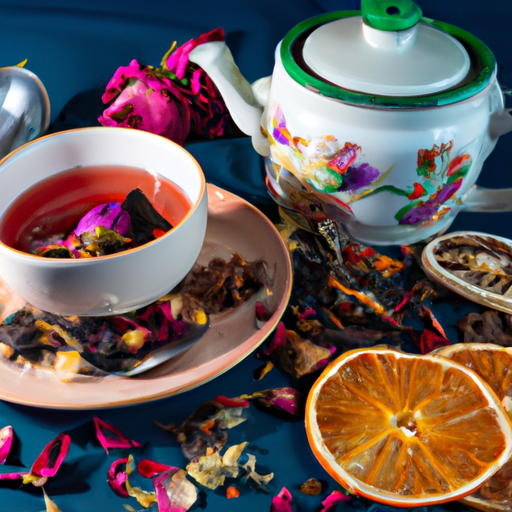
 Tea Brewing and Preparation4 weeks ago
Tea Brewing and Preparation4 weeks agoExploring English Breakfast Tea: Flavors, Blends, And Recommendations
-

 Tea Brewing and Preparation4 weeks ago
Tea Brewing and Preparation4 weeks agoStarting A Profitable Tea Business: Tips, Resources, And Success Stories
-

 Tea Brewing and Preparation1 month ago
Tea Brewing and Preparation1 month agoHow To Cold Steep Tea (And Why!)
-

 Herbal Tea2 weeks ago
Herbal Tea2 weeks agoWhat Happened To Cup Of Life Organic Herbal Tea
-
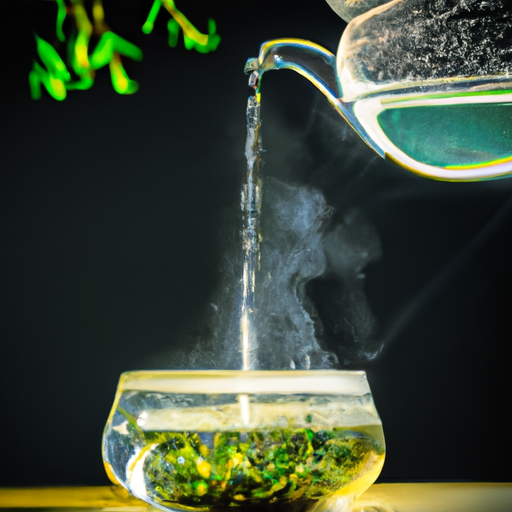
 Herbal Tea2 weeks ago
Herbal Tea2 weeks agoHow Much Water To Use For Herbal Tea









